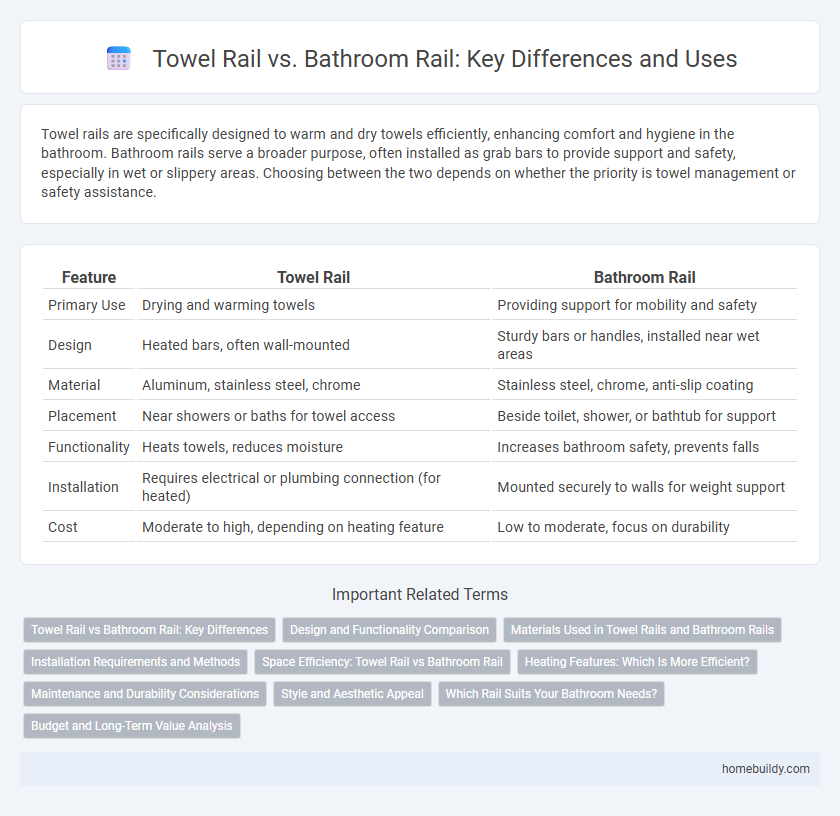Towel rails are specifically designed to warm and dry towels efficiently, enhancing comfort and hygiene in the bathroom. Bathroom rails serve a broader purpose, often installed as grab bars to provide support and safety, especially in wet or slippery areas. Choosing between the two depends on whether the priority is towel management or safety assistance.
Table of Comparison
| Feature | Towel Rail | Bathroom Rail |
|---|---|---|
| Primary Use | Drying and warming towels | Providing support for mobility and safety |
| Design | Heated bars, often wall-mounted | Sturdy bars or handles, installed near wet areas |
| Material | Aluminum, stainless steel, chrome | Stainless steel, chrome, anti-slip coating |
| Placement | Near showers or baths for towel access | Beside toilet, shower, or bathtub for support |
| Functionality | Heats towels, reduces moisture | Increases bathroom safety, prevents falls |
| Installation | Requires electrical or plumbing connection (for heated) | Mounted securely to walls for weight support |
| Cost | Moderate to high, depending on heating feature | Low to moderate, focus on durability |
Towel Rail vs Bathroom Rail: Key Differences
Towel rails are specifically designed for drying and warming towels with integrated heating elements, while bathroom rails primarily serve as support or grab bars for safety in wet environments. Towel rails often feature sleek, heated bars made from materials like stainless steel or chrome, enhancing comfort and hygiene by reducing dampness. In contrast, bathroom rails prioritize sturdy construction and grip, usually installed near showers or toilets to assist mobility and prevent slips.
Design and Functionality Comparison
Towel rails offer sleek, space-efficient designs that prioritize drying efficiency with evenly spaced bars, while bathroom rails often emphasize sturdiness and multipurpose use, such as supporting grab bars or holding multiple accessories. The design of towel rails typically incorporates heat elements for faster drying, enhancing functionality beyond basic hanging, whereas bathroom rails focus on structural strength and versatility in placement. Functionality in towel rails centers on temperature control and moisture management, contrasting with bathroom rails designed primarily for safety and convenience in various bathroom zones.
Materials Used in Towel Rails and Bathroom Rails
Towel rails are typically made from stainless steel, chrome, or aluminum due to their resistance to corrosion and heat, ensuring durability and efficient heat conduction for drying towels. Bathroom rails, often used as grab bars or support rails, prioritize materials like stainless steel or brass, which provide strength, rust resistance, and compliance with safety standards. The choice of materials directly impacts functionality, longevity, and maintenance requirements in both towel and bathroom rail applications.
Installation Requirements and Methods
Towel rails typically require wall mounting with secure anchors to support wet towels, often installed near sinks or bathtubs for easy access and efficient drying. Bathroom rails, designed for added safety, demand robust installation into wall studs or solid surfaces to support body weight, often involving heavier-duty brackets and screws. Proper alignment, use of level tools, and adherence to manufacturer guidelines ensure stability and compliance with building codes for both types of rails.
Space Efficiency: Towel Rail vs Bathroom Rail
Towel rails offer superior space efficiency compared to traditional bathroom rails by combining heating functionality with drying capability, reducing the need for separate fixtures. Their vertical design maximizes wall space, making them ideal for compact bathrooms where saving floor area is crucial. Unlike bulky bathroom rails, towel rails provide streamlined storage and quicker towel drying, enhancing both utility and comfort in small spaces.
Heating Features: Which Is More Efficient?
Towel rails are specifically designed to provide consistent heat output, efficiently warming towels while contributing to bathroom warmth without excessive energy consumption. Bathroom rails, often larger and less targeted, may disperse heat unevenly and require more energy to maintain desired temperatures. Choosing a towel rail with integrated heating technology ensures optimal heat distribution and energy efficiency compared to standard bathroom rails.
Maintenance and Durability Considerations
Towel rails typically require less maintenance due to their simpler design and corrosion-resistant materials like stainless steel or anodized aluminum, offering long-lasting durability in humid bathroom environments. Bathroom rails, often made from a variety of materials including wood or plastic, may need more frequent upkeep to prevent moisture damage and wear. Selecting a towel rail with rust-proof coatings and robust construction enhances durability and minimizes maintenance efforts in wet conditions.
Style and Aesthetic Appeal
Towel rails offer a sleek, minimalist design that enhances bathroom style with clean lines and modern materials, creating an organized and visually appealing space. Bathroom rails, often bulkier and utilitarian, prioritize functionality but can disrupt the overall aesthetic by appearing more industrial or traditional. Choosing a towel rail elevates the bathroom's decor by seamlessly blending form and function, making it a preferred choice for contemporary interiors focused on style and elegance.
Which Rail Suits Your Bathroom Needs?
Towel rails are specifically designed to dry and warm towels efficiently, featuring heated bars and optimized spacing for airflow, which prevents dampness and mildew. Bathroom rails, often serving as grab bars or towel holders, prioritize safety and support, making them ideal for users with mobility concerns or for wet areas requiring sturdy fixtures. Choosing between the two depends on whether your bathroom prioritizes comfort and towel maintenance or accessibility and safety features.
Budget and Long-Term Value Analysis
Towel rails generally offer a more affordable upfront cost compared to bathroom rails, making them ideal for budget-conscious renovations. High-quality towel rails made from durable materials like stainless steel provide long-term value through corrosion resistance and minimal maintenance. Investing in an energy-efficient heated towel rail can reduce utility bills over time, making it a cost-effective option despite a higher initial price.
Towel rail vs Bathroom rail Infographic

 homebuildy.com
homebuildy.com